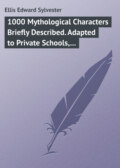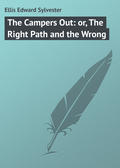
Ellis Edward Sylvester
Ellis's Primary Physiology. Or Good Health for Boys and Girls
CHAPTER XIV
ACCIDENTS AND EMERGENCIES
This little book is not intended to take the place of the physician, but is meant to help you to get along without him. We are all liable to accidents, and you should know what to do in such cases, before the doctor reaches you. Besides, you can often help yourself, and will not need the doctor.
HABITS TO CULTIVATE
Cultivate regularity in all good habits. The hour for going to bed, and for rising, for eating your meals, for study, and for play, indeed, the time for every duty relating to your body, should, as nearly as possible, be just the same, day after day.
BLISTERS
If a blister forms anywhere on the body, do not prick it. If you do, a sore will form. Leave it alone until it breaks of itself. By that time (generally in two or three days) a new skin will have formed, and the blister will pass away almost unnoticed.
BOILS, STINGS OF INSECTS, AND BURNS
The skin of a boiled egg is a good remedy for boils. Peel it carefully, wet and apply to the part affected. The stings of insects may be covered with moistened earth. Slight burns will cause little pain, if the air is shut out by means of paste or anything of that nature.
BLEEDING OF THE NOSE
For continued bleeding at the nose, apply ice or cold water to the back of the neck and push a plug of cotton, or soft rag covered with powdered alum up the nose. The “door-key” is good, because it is cold; any other piece of cold metal will do as well.
FIRE
If your clothing should catch fire, keep your senses about you. Do not start on a run, unless the distance is very short to open water, into which you can plunge. An overcoat, blanket or piece of carpet, wrapped closely about the body, will smother the flames.
FAINTING
If a person faints he should be laid flat on his back, given fresh air, and water sprinkled in his face. The clothing about the neck should be thrown open, and people prevented from crowding around.
FROST-BITTEN FEET AND EARS
Sometimes when a boy uses his skates too long, or he is exposed for a good while to bitterly cold weather, his feet or ears become frost-bitten. When this mishap takes place, he is apt to do the very thing he ought not to do.
He must not approach a fire, enter a warm room, nor use warm water or clothing. When any part of the body is frozen, snow should be constantly applied to it. If no snow is at hand, the coldest water that can be obtained must be used with cloths, until the frozen member is gradually thawed out.
SLIGHT CUTS AND WOUNDS
All boys use jack-knives, and now and then inflict cuts upon themselves. As a rule, these do not amount to much, and only require to be washed with cold water and bound up with a clean rag; but, if a vein or artery is severed, there is great danger.
HOW TO TREAT A BLEEDING ARTERY
If an artery is cut, the blood will be bright red, and will come out in jets, corresponding with the throbbing of the heart. As the arteries take the blood from the heart, the proper thing to do is to press the thumb strongly upon the artery just above the wound. Then a handkerchief should be knotted around the arm or leg, as the case may be, above the hurt; a stick placed under the bandage, and twisted about until the flow of blood is stopped. This will answer until the surgeon can be brought.
CUT VEINS AND BROKEN LIMBS
The veins carry the blood back to the heart. If one is cut the blood is dark and flows steadily. It is managed more easily than an artery; all that need be done is to place some lint over the wound and bandage it firmly. This, of course, you will do as soon as possible.
If you should be so unfortunate as to break or dislocate a limb, assume an easy position and calmly await the coming of the surgeon. If a finger only is fractured you can walk to his office.
What is said of this little book? To what are we liable and what should we know?
What should be cultivated?
What is the rule concerning a blister which may form on any part of the body?
What is a good thing for boils? For the stings of insects? For slight burns?
What is the remedy for continued bleeding at the nose?
What is the proper course if your clothing should take fire?
What should be done with a person when he faints?
What is a boy apt to do when his ears or feet are frost-bitten?
Give the proper course to be followed.
What should be done with a slight cut?
How can you know that an artery has been cut? What must be done?
What is the office of the veins? What need be done if one of them is wounded?
Suppose your arm or leg is broken, what is the proper course? If it is only a finger?
CHAPTER XV
THE NERVES, BRAIN, SPINAL CORD, ETC
The muscles which move the bones are themselves moved by the nerves. The nerves are soft and pulpy in youth, but harden as you advance in years. They are composed of a gray substance, called the nerve-cell, and a white substance, known as the nerve-fibre.
The brain is the mass of nervous tissue within the skull. It is so tender and easily harmed that nature has walled it about by a hard, bony structure to protect it from injury.
The gray substance of the nerves is where nervous impulses begin, which are conducted along the white substance. The gray matter may be compared to a telegraph office where the message is started, while the white matter is the wire along which the message travels.
The spinal cord, or marrow, is a mass of soft, nervous tissue, which fills the hollow running the length of the spine or backbone.
From the base of the brain twelve pairs of nerves are given off to the face and head. One pair passes to the eye, and gives sight; one passes to the nose, and gives smell; one, to the mouth, tongue, and palate, and gives taste; one, to the ears, and gives hearing; and others to the face, neck, and head, and give the expressions of joy, sorrow, pain, anger, and doubt.
From the spinal cord thirty-one pairs of nerves pass to the various parts and organs of the body.
There could be no motion or feeling without the nerves, although they are not the true centres of either. If you obey the rules of health, as already laid down, you will be in the happy condition of those of whom it is said they do not feel that they have any nerves at all.
What move the muscles? How are the nerves in early youth? Of what are they composed? What are these parts called?
What is the brain? How is it protected?
Where do nervous impulses begin? To what may the gray and white matter be compared?
What is the spinal cord?
How many pairs of nerves are given off from the brain? From the spine? Where do they go?
What is said of sensation and feeling? What if you obey the laws of health?
CHAPTER XVI
SUNSTROKE AND POISONS
Don't be afraid of the sun. Its rays give life and vigor not only to men and animals, but to the vegetable world. A little tanning or browning of the skin is good for you. In summer when the rays are very strong, you should avoid them; but at other times, live in the sunlight all you can.
Very rarely indeed is a child sunstruck; but it is wise to guard against it, because it is often fatal. As I have just told you, you must keep out of the direct rays of the sun when the day is very hot. It is well to carry a wet handkerchief, or several large green leaves in the crown of your hat.
SYMPTOMS OF SUNSTROKE
The symptoms of sunstroke are stinging pains in the head, dizziness, weakness, confusion of sight, and in some cases, sickness at the stomach. The person becomes partly or wholly insensible and often moans or snores. Sometimes he has spasms.
HOW TO TREAT SUNSTROKE
Should you ever see any one thus affected, do your utmost to have him taken at once to the coolest place that is near at hand, and where there is plenty of fresh air. The clothing should be removed and the body sponged with cold water, if the surface is warm; if it is cool, warm water should be used.
If the patient's body is very hot, his pulse high, he snores or moans, and is limp and senseless, he should be laid upon his face, his head slightly raised and cold water poured upon it for several minutes, from a height of four or five feet.
CAUTION
If the pulse is feeble and fast, the breathing light, and the body cool, the treatment just named would be highly dangerous. The patient must be given small doses of diluted brandy or whiskey, and a blister applied to the back of the neck. Of course a physician will be sent for at once.
POISONS
It may happen that a child swallows by mistake some kind of poison (when he is alone), and when a few minutes' delay in reaching a physician will be fatal. The best and indeed the only thing to do is to produce instant vomiting. Stir a tablespoonful of salt or a teaspoonful of mustard in a tumbler of warm water and swallow without a moment's delay.
At the end of five minutes, repeat the dose, and continue doing so for half an hour. If vomiting does not take place immediately, bring it on by thrusting the forefinger down the throat, since vomiting alone will save your life.
SULPHURIC ACID POISON
There is but one poison which cannot be thrown off by the means just described. If water is drank directly after swallowing sulphuric acid, it will be fatal. Vomiting must be induced by using the finger.
A SAFE RULE
The only safe rule for children, as well as for grown persons, is never to swallow or touch anything which they are not certain can do them no harm. When there is the least doubt, leave it alone.
What is said of sunlight? When should the rays be avoided?
What should be carried in the crown of the hat when the sunlight is very strong?
Describe the symptoms of sunstroke.
What is the first thing to do when a person suffers sunstroke? Suppose the surface of the body is warm? Suppose it is cool?
If the body is hot, pulse high, he snores, is limp, etc.?
If the pulse is feeble and fast, breathing light, body cool?
What course should be followed if poison is taken by mistake? Suppose the dose described does not cause vomiting?
What of sulphuric acid?
What is the only safe rule?







